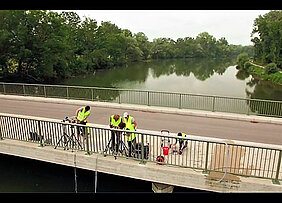Since 2017, the joint research project MicBin has been investigating how plastics and, in particular, so-called microplastics get into rivers, what happens to them there and how they can be sampled and analysed. The project coordinator, Dr. Nicole Zumbülte, gave a detailed interview to the German Federal Ministry of Education and Research (BMBF) on the results and conclusions from MicBin. At the same time, an informative short video has been released, summarising the work of the scientists in 2 minutes.
In the joint research project MicBin, seven partners under the coordination of TZW: DVGW-Technologiezentrum Wasser (German Water Centre) investigated the input and fate of plastic particles of various sizes in the German Danube catchment area. The focus was mainly on so-called microplastics - tiny particles that can be as small as one thousandth of a millimeter. The researchers determined the amount of microplastics in several Danube tributaries, investigated sources and sinks, and identified possible measures in models that could reduce the input of plastic particles into the Danube catchment. MicBin was funded by the BMBF with 2.3 million € within the research focus Plastic in the Environment. The project duration was 3.5 years and started on 01.10.2017. Participants were: Osnabrück University, Augsburg University, the German Federal Institute of Hydrology (BfG), TH Köln – University of Applied Sciences, Bavarian Environment Agency, the BKV and TZW: DVGW-Technologiezentrum Wasser (German Water Centre).
The interview and the film can be found in full length on the BMBF website.

![[Translate to English:] Prüfstelle-Produktprüfung_Teststand Test centre and product testing](/fileadmin/_processed_/0/9/csm_TZW-Karlsruhe_Pruefung_Geraete-Teststand_377188946c.jpg)
























